#Microsoft flow
Explore tagged Tumblr posts
Text
Power Automate Benefits And Use Cases
In today’s tech-driven world, businesses need to stay ahead of the curve to maintain a competitive edge. This is where Power Automate comes in. Formerly known as Microsoft Flow, Power Automate is a cloud-based service that allows you to create automated workflows between your favorite apps and services to simplify your work and increase efficiency.
Power Automate has a wide range of benefits and use cases that can transform the way you work. Whether it’s streamlining repetitive tasks, integrating apps and data across different platforms, or automating complex business processes, Power Automate can help you achieve it all. With its user-friendly interface and extensive library of pre-built templates, you can easily create customized workflows that cater to your specific business needs.
In this blog post, our Microsoft Flow experts dive deeper into the world of Power Automate and explore some of its most significant benefits and use cases. We’ll also share some real-world examples of how Power Automate has helped businesses streamline their operations and boost productivity. So, sit back, relax, and let’s explore the wonderful world of Power Automate!
#power platform consulting#managed it services#power automate#Power automate services#Microsoft flow
1 note
·
View note
Text
As businesses seek to improve efficiency in 2024, smart document automation is becoming a crucial tool for streamlining workflows and reducing manual effort. With the demand for faster, more accurate document management, organizations are turning to advanced automation solutions that integrate seamlessly with existing systems. In addition to saving organizations time, these trends are also lowering operating expenses and increasing overall productivity.One of the most significant trends is the increased use of Power Automate development services to create customized automation solutions. Companies are leveraging Power Automate to design custom workflows that eliminate the need for repetitive tasks like data entry, approval processes, and document routing. By automating these processes, businesses can improve accuracy, speed up document handling, and free up employees to focus on higher-value tasks. This trend is transforming how organizations manage everything from invoices to contracts, improving overall operational efficiency. Another emerging trend is the adoption of comprehensive automation that covers the entire document workflow from start to finish. This approach enables organizations to manage the whole document lifecycle from creation to storage with minimal human intervention. Document management systems are now using automation to capture, process, and store documents efficiently, ensuring that businesses can stay compliant and handle large volumes of paperwork with ease. With more companies adopting these systems, the ability to track and manage documents in real-time is becoming a game-changer. The demand for Power Automate consulting services is also on the rise. As businesses look to optimize their document automation strategies, expert consultants are helping them implement solutions that align with their specific needs. Whether it's improving an existing system or developing new automation workflows, consulting services provide businesses with the necessary expertise to make the most of Power Automate tools. By working with consultants, companies can avoid costly mistakes and ensure a smooth transition to automated workflows. These trends are proving that smart document automation is not just about increasing efficiency but also about improving accuracy and compliance. As more businesses adopt automation solutions, it's clear that embracing these innovations in 2024 will be key to staying competitive and enhancing long-term productivity.
#hire microsoft power automate consultants#microsoft flow consulting services#microsoft power automate consultants#microsoft power automate consulting#microsoft power automate services#power automate consulting provider#power automate consulting services#power automate development#power automate development services#power automate services#power automate solutions provider#power automate workflows#power platform development#workflow automation solutions
0 notes
Text
Empowering Your Business with AI: Building a Dynamic Q&A Copilot in Azure AI Studio
In the rapidly evolving landscape of artificial intelligence and machine learning, developers and enterprises are continually seeking platforms that not only simplify the creation of AI applications but also ensure these applications are robust, secure, and scalable. Enter Azure AI Studio, Microsoft’s latest foray into the generative AI space, designed to empower developers to harness the full…

View On WordPress
#AI application development#AI chatbot Azure#AI development platform#AI programming#AI Studio demo#AI Studio walkthrough#Azure AI chatbot guide#Azure AI Studio#azure ai tutorial#Azure Bot Service#Azure chatbot demo#Azure cloud services#Azure Custom AI chatbot#Azure machine learning#Building a chatbot#Chatbot development#Cloud AI technologies#Conversational AI#Enterprise AI solutions#Intelligent chatbot Azure#Machine learning Azure#Microsoft Azure tutorial#Prompt Flow Azure AI#RAG AI#Retrieval Augmented Generation
0 notes
Text
#power automate consulting#power automate platform#use power automate#power automate use case#power automate online#microsoft power automate examples#benefits of power automate#power automate examples#microsoft power automation#power automate 365#powerautomate flow#power automate sharepoint#automate microsoft#power automation microsoft#power automate tasks
0 notes
Text

時間の流れに身を浸し、無為を贅として貪る。 過去のどの王も皇帝も、神ですら到達しえなかった虚無の至福…。
Immerse yourself in the flow of time and devour inaction as luxury. The bliss of emptiness that no past kings, emperors, or even god have been able to attain….
#microsoft bing#image creator#DALL-E3#ai art#ai generated#aphorism#pessimism#pessimist#pessimistic#pessimistic poor writing#厭世主義的駄文#flow#time#devour#inaction#luxury#bliss#emptiness#kings#emperors#god
0 notes
Text
Microsoft Office 365 The Productivity in Your Hands

In today's fast-paced and technologically-driven world, productivity is of utmost importance. With numerous tasks to juggle, deadlines to meet, and projects to complete, professionals are constantly searching for efficient solutions to manage their workload.
Microsoft Office 365 is one such solution that puts productivity directly in the hands of its users.
Office 365 encompasses a suite of popular productivity tools, including Word, Excel, PowerPoint, Outlook, and more. However, it goes beyond the traditional desktop software by offering cloud-based features and collaborative capabilities.
This means that users can access their documents, spreadsheets, and presentations anytime, anywhere, with any device, as long as they have an internet connection.

The flexibility offered by Office 365 allows individuals and teams to work remotely, ensuring that productivity is not limited by physical boundaries.
Whether you are at home, on the go, or in the office, you can easily collaborate with colleagues, share files, and engage in real-time communication. This eliminates the need for constant email exchanges, tedious version control, and delays in decision-making.
One of the key highlights of Office 365 is its real-time collaboration feature. Multiple users can work on the same document simultaneously, making editing, reviewing, and finalizing projects a seamless process.
Whether it is a group brainstorming session, a finance spreadsheet, or a marketing presentation, everyone can contribute and see updates in real-time.
This not only saves time but also enhances teamwork and fosters a sense of accountability.

Furthermore, Office 365 offers integrated communication tools like Microsoft Teams, which facilitate efficient collaboration and streamline project management.
Users can create channels for specific topics, have virtual meetings, and chat in real-time. This ensures that team members are always connected, eliminating any communication barriers and allowing for quick decision-making and problem-solving.
Another significant advantage of Office 365 is its scalability and cost-efficiency. Users can choose from various subscription plans, tailored to meet the needs of different individuals and organizations.
This means that whether you are a freelancer, a small business owner, or part of a large corporation, Office 365 can be customized to suit your requirements.
Additionally, with automatic updates and continuous improvements, users always have access to the latest features and security enhancements without the need for manual installations or expensive upgrades.

Some tips for getting the most out of Microsoft 365:
Take advantage of the training: Microsoft offers a variety of training resources for Microsoft 365. This training can help you learn how to use the applications more effectively.
Use the cloud: Microsoft 365 is available in the cloud, so you can access your applications and data from anywhere. This can be a great way to work from home or on the go.
Collaborate with others: Microsoft 365 makes it easy to collaborate with others on projects. Use features such as document sharing and real-time co-authoring to work together more effectively.
Use the latest features: Microsoft 365 is constantly being updated with new features. Make sure to check out the latest features to see how they can help you be more productive.

In conclusion, Microsoft Office 365 is a game-changer when it comes to boosting productivity. By providing users with cloud-based access, collaborative features, and integrated communication tools, Office 365 ensures that productivity is no longer confined to a physical workspace. It empowers individuals and teams to work efficiently, streamline workflows, and achieve more in less time. With Office 365, productivity truly is in the hands of its users, offering a seamless and powerful solution to manage the demands of the modern world.
#microsoft office 365#office 365#microsoft office#Microsoft 365#cloud-based#productivity tools#work flow#integrated communication tools#teamwork
0 notes
Text
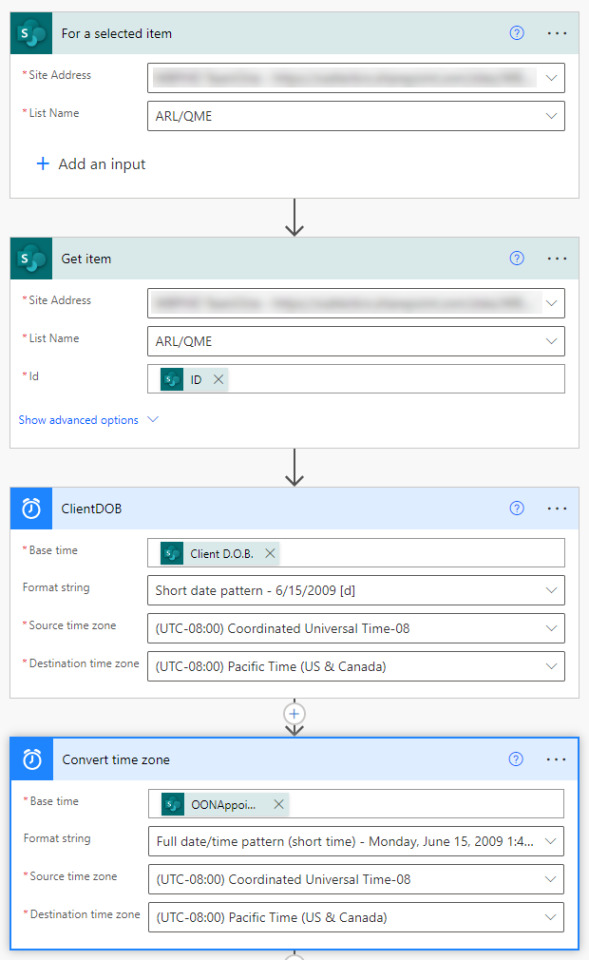
This is the first part of sending 2 Adobe Acrobat sign documents and a welcome letter to a client email address that was triggered from a SharePoint list. The data will be dynamically populated from the list to fields in the Acrobat sign document and the welcome letter.
It is not exactly what everybody might need, but has lots of tips to help you with your own Microsoft Automate flow projects and SharePoint. 1) The trigger. SharePoint - For a selected Item. Self explanatory :-) When you have rows in a SharePoint list. You would select the record and then click the automation tab your flow will appear.
2) SharePoint - Get Item. Gives you accesses to the list fields and potential data.
3) A date convertor component. Further on in the agreement, a DOB (date of birth - a date field) is needed. Dates come out in UTC format these components convert the formatting to your area or preference. A little more later on. 4) Another date convert. Name them to make easier for identification Top right - the 3 dots in a component.
5) Select an Adobe connector - "Create an agreement from a library template and send for signature."
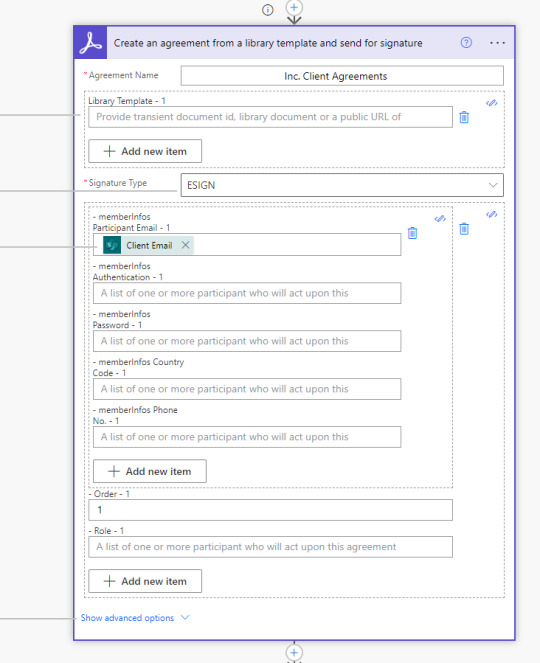

The .pdf part
At this point, you need to create a .pdf file. (the form that the recipient receives). The .pdf file needs to be in your Adobe cloud files as a Template. The libraryDocumentId - (to identify which .pdf/file to send) is a bit tricky to get/determine. I could not find it anywhere (really poorly done on Adobe's part.) How hard could it be?, select the file and see properties or something. Anyway, if you search online the only results were found was to run commands through the API. I did not have access to the API at the time. I got it by logging into the adobe account and opening the .pdf with it open look at its URL of the agreement in the browser's address bar. The ID usually starts with CBJCH.

On creating forms to use as a pdf. You can use excel to design your forms and print to .pdf. I find the Adobe web based designer to be just awful with limited design abilities and frustrating snap to settings that can not be disabled. You can use MS Word or any software that can print to a .pdf printer (built-in on windows 10)
More about the Adobe component/connector
Signature type: ESIGN Means the primary interaction is to have the document signed by the recipient.
Participant Email - 1. Where/whom to send to. Can come from your SharePoint list - an email address field - as to where it would be sent. Select from the dynamic list.
Agreement Name - can be whatever you like.
Show advance options:
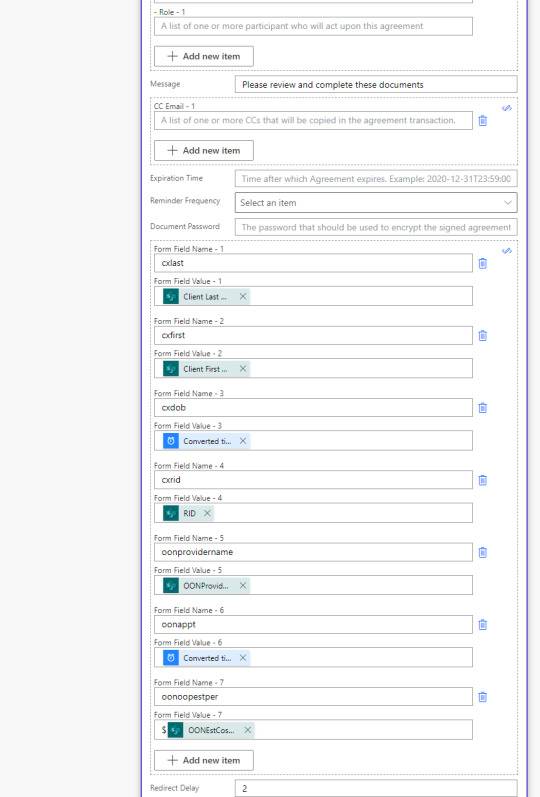
In the web based UI of Adobe you will be configuring your .pdf form. For example, you drag the signature block over on the form to where it should be positioned.
You can further customize your forms with custom and dynamic values from your SharePoint list. In Adobe, you would drag over a text block and position on your form. You will name that text block and make it read only (it will show the value in the text block that you made in Adobe. See the above image Form Field Name - 1
Form field value: choose your field from the Power Automate dynamic list. Redirect delay. After the recipient signs and clicks/taps submit, you can delay and then link to a website/resource. Dates and decimals: Any time you need these data types. You need to convert the output to your proper format. Using expressions or convert components. Furthermore, they don't like NULL values. If any of the date/decimals fields can be (possibly) NULL configure the component(s) run after settings. The setting will allow a NULL value and the flow will just continue - instead the flow would fail.
In the image below a NULL value warning even after the successful run was complete.
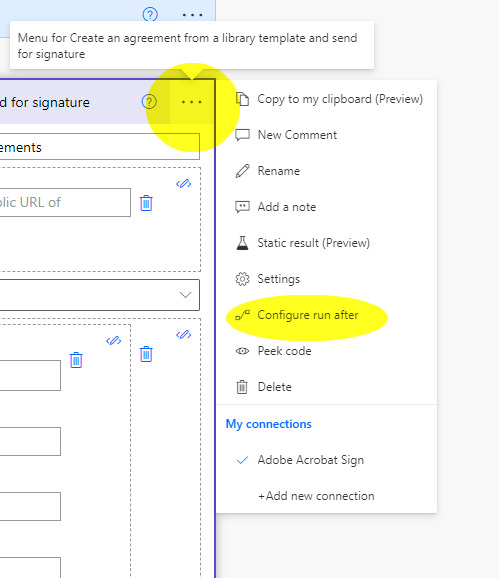
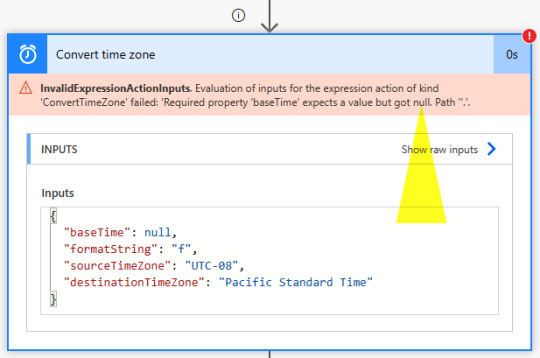


The complete flow.
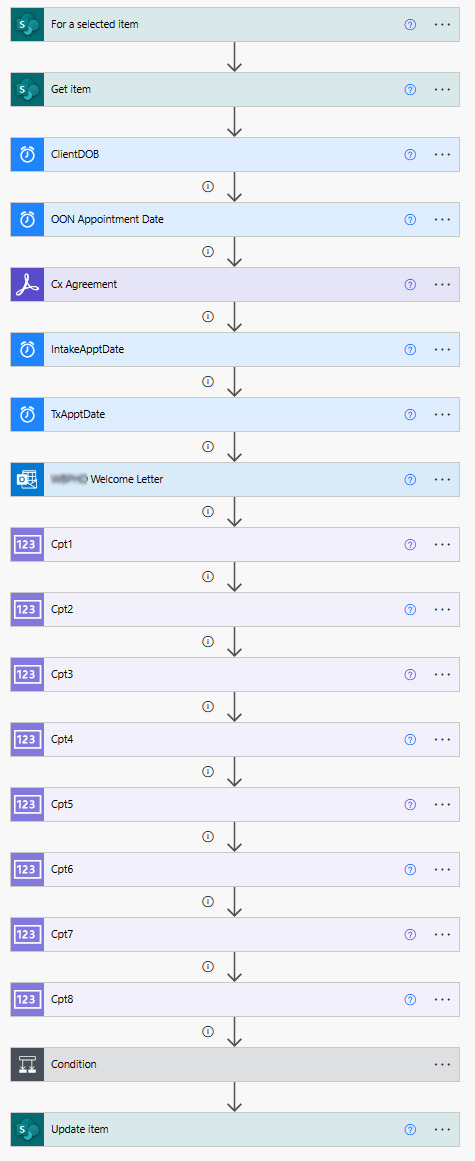
#automation#Flow#Microsoft Power Automate#information technology#design#business technology#robotic automation#logic#computer science#programming#database#data visualization#software#datascience#dataanalytics#dataanalysis#data management#data manipulation
0 notes
Text
[Fabric] Integración de datos al OneLake
Ya viste todos los videos con lo que Fabric puede hacer y queres comenzar por algo. Ya leiste nuestro post sobre Onelake y como funciona. Lo siguiente es la ingesta de datos.
En este artículos vamos a ver muchas formas y opciones que pueden ser usadas para añadir datos a onelake. No vamos a ver la profundidad de como usar cada método, sino una introducción a ellos que nos permita elegir. Para que cada quien haga una instrospección de la forma deseada.
Si aún tenes dudas sobre como funciona el Onelake o que es todo eso que apareció cuando intentaste crear uno, pasa por este post para informarte.
Ingesta de datos
Agregar datos al Onelake no es una tarea difícil pero si analítica puesto que no se debe tomar a la ligera por la gran cantidad de formas disponibles. Algunas serán a puro click click click, otras con más o menos flexibilidad en transformaciones de datos, otras con muchos conectores o tal vez con versatilidad de destino. Cada forma tiene su ventaja y posibilidad, incluso puede que haya varias con la que ya tengan familiaridad.
Antes de iniciar los métodos repasemos que para usar nuestro Onelake primero hay que crear una Lakehouse dentro de un Workspace. Ese Lakehouse (almacenado en onelake) tiene dos carpetas fundamentales, Files y Tables. En Files encontrabamos el tradicional filesystem donde podemos construir una estructura de carpetas y archivos de datos organizados por medallones. En Tables esta nuestro spark catalog, el metastore que puede ser leído por endpoint.

Nuestra ingesta de datos tendrá como destino una de estos dos espacios. Files o Tables.
Métodos
Data Factory Pipelines (dentro de Fabric o Azure): la herramienta clásica de Azure podría ser usada como siempre lo fue para este escenario. Sin embargo, hay que admitir que usarla dentro de Fabric tiene sus ventajas. El servicio tiene para crear "Pipelines". Como ventaja no sería necesario hacer configurationes como linked services, con delimitar la forma de conexión al origen y seleccionar destino bastaría. Por defecto sugiere como destino a Lakehouse y Warehouse dentro de Fabric. Podemos comodamente usar su actividad estrella "Copy Data". Al momento de determinar el destino podremos tambien elegir si serán archivos en Files y de que extensión (csv, parquet, etc). Así mismo si determinamos almacenarlo en Tables, automáticamente guardará una delta table.
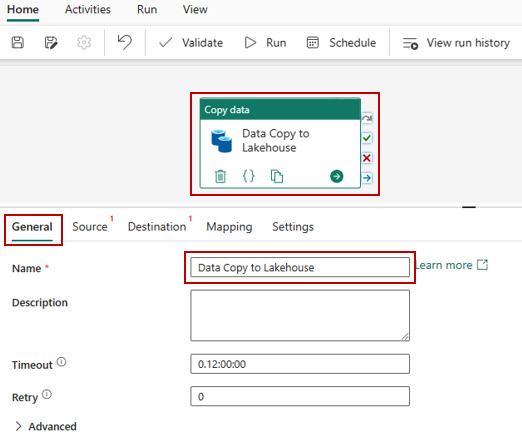
Data Factory Dataflows Gen2: una nueva incorporación al servicio de Data Factory dentro de Fabric son los Dataflows de Power Query online. A diferencia de su primera versión esta nueva generación tiene fuertes prestaciones de staging para mejor procesamiento, transformación y merge de datos junto a la determinación del destino. Así mismo, la selección del destino nos permite determinar si lo que vamos a ingestar debería reemplazar la tabla destino existente o hacer un append que agregue filas debajo. Como ventaja esta forma tiene la mayor cantidad de conectores de origen y capacidades de transformación de datos. Su gran desventaja por el momento es que solo puede ingestar dentro de "Tables" de Lakehouse bajo formato delta table. Mientras este preview también crea unos elementos de staging en el workspace que no deberíamos tocar. En un futuro serán caja negra y no los veremos.
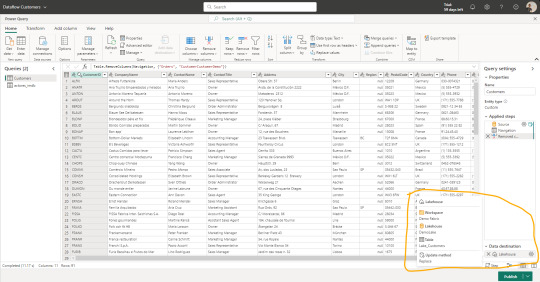
Notebooks: el hecho de tener un path a nuestro onelake, path al filesystem con permisos de escritura, hace que nuestro almacenamiento pueda ser accedido por código. El caso más frecuente para trabajarlo sería con databricks que, indudablemente, se convirtió en la capa de procesamiento más popular de todas. Hay artículos oficiales de la integración. En caso de querer usar los notebooks de fabric también son muy buenos y cómodos. Éstos tienen ventajas como clickear en files o tablas que nos genere código de lectura automáticamente. También tiene integrada la herramienta Data Wrangler de transformación de datos. Además cuenta con una muy interesante integración con Visual Studio code que pienso podría integrarse a GitHub copilot.
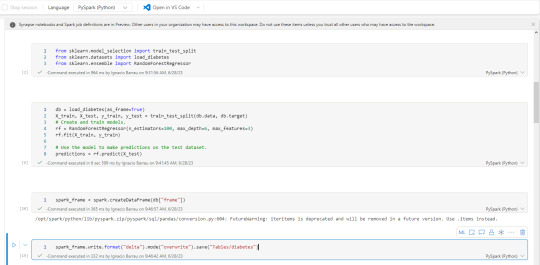
Shortcuts (accesos directos): esta nueva opción permite a los usuarios hacer referencia a datos sin copiarlos. Genera un puntero a archivos de datos de otro lakehouse del onelake, ADLS Gen2 o AWS S3 para tenerlo disponible como lectura en nuestro Lakehouse. Nos ayuda a reducir los data silos evitando replicación de datos, sino punteros de lectura para generar nuevas tablas transformadas o simplemente lectura para construcción de un modelo o lo que fuere. Basta con clickear en donde lo queremos (tables o files) y agregarlo.
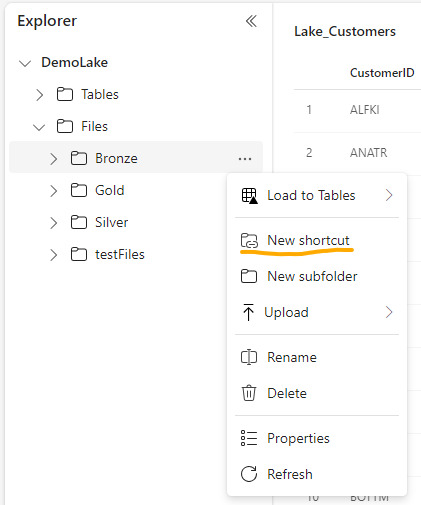
Upload manual: con la vista en el explorador de archivos (Files) como si fuera un Azure Storage explorer. Tenemos la clásica posibilidad de simplemente agregar archivos locales manualmente. Esta posibilidad solo estaría disponible para el apartado de Files.
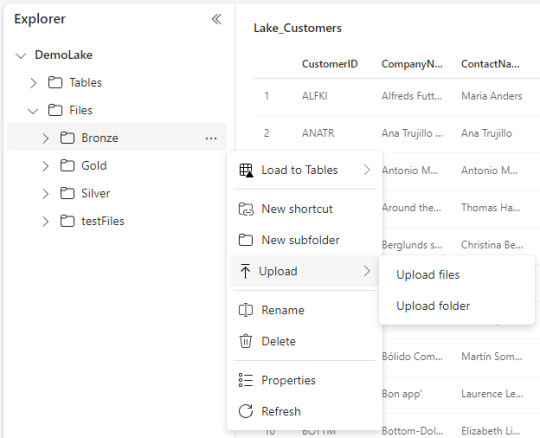
Explorador de archivos Onelake (file explorer): una de las opciones más atractivas en mi opinión es este cliente para windows. Es incontable la cantidad de soluciones de datos que conllevan ingresos manuales de hojas de cálculo de distintas marcas en distintas nubes. Todas son complicadas de obtener y depositar en lake. Esta opción solucionaría ese problema y daría una velocidad impensada. El cliente de windows nos permite sincronizar un workspace/lakehouse que hayan compartido con nosotros como si fuera un Onedrive o Sharepoint. Nunca hubo una ingesta más simple para usuarios de negocio como ésta que a su vez nos permita ya tener disponible y cómodamente habilitado el RAW del archivo para trabajarlo en Fabric. Usuarios de negocio o ajenos a la tecnología podrían trabajar con su excel cómodos locales y los expertos en data tenerlo a mano. Link al cliente.
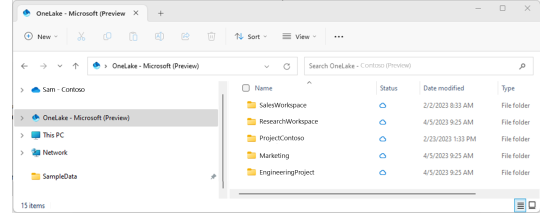
Conclusión
Como pudieron apreciar tenemos muchas formas de dar inicio a la carga del onelake. Seguramente van a aparecer más formas de cargarlo. Hoy yo elegí destacar éstas que son las que vinieron sugeridas e integradas a la solución de Fabic porque también serán las formas que tendrán integrados Copilot cuando llegue el momento. Seguramente los pipelines y notebooks de Fabric serán sumamente poderosos el día que integren copilot para repensar si estamos haciendo esas operaciones en otra parte. Espero que les haya servido y pronto comiencen a probar esta tecnología.
#fabric#fabric tutorial#fabric tips#fabric training#data fabric#data engineer#data engineering#microsoft fabric#fabric argentina#fabric jujuy#fabric cordoba#ladataweb#power query#power query online#powerbi#power bi#power bi dataflows#data factory#data factory data flows#power bi service
0 notes
Text
0 notes
Text
America and “national capitalism”

I'm on a 20+ city book tour for my new novel PICKS AND SHOVELS. Catch me in LA TONIGHT (Feb 19) for an event with WIL WHEATON in LA, and in SEATTLE TOMORROW (Feb 19) for with DAN SAVAGE. More tour dates here.

Thomas Piketty's 2013 unexpected bestseller (a 750 page economics book translated from French!) Capital in the 21st Century, offers a very convincing explanation of our political decay, and it continues to serve this purpose as the decay undergoes alarming acceleration:
https://memex.craphound.com/2014/06/24/thomas-pikettys-capital-in-the-21st-century/
Let me sketch out that argument really briefly for you here. Absent any kind of government intervention, markets make investors richer than workers (AKA "the rate of return on capital exceeds the rate of return from growth" or "r > g"). This is true even for extremely powerful workers who get very, very rich indeed. Piketty illustrates this in many ways, but my favorite is the Parable of Bill Gates, Liliane Bettencourt and Bill Gates (again).
Bill Gates founded Microsoft in 1975 and he stepped down as CEO in 2000. In the intervening 25 years, he built the company into the most profitable firm in human history and grew very, very rich. This is Market Lore Canon: found a successful company, grow rich.
Now, Bill Gates started with a bunch of money – he comes from a wealthy family – but he grew his personal fortune over those years in extraordinary ways, and not by investing it, but rather, by founding a company and working at it.
Now consider Liliane Bettencourt, who, during Bill Gates period as Microsoft CEO, was the richest woman in Europe. Bettencourt was born very, very rich, heiress to the L'Oreal fortune. Unlike Gates, Bettencourt didn't have a job. She just sat around, while financial planners invested her family money. Over the 25 years when Bill Gates was growing Microsoft from zero to the most successful company in planetary history, Bettencourt made more money than Gates. Gates made his money by doing something. Bettencourt made her money by emerging from a very lucky orifice and just hanging around.
But here's the kicker: after Bill Gates quit Microsoft, he became a professional investor. He stopped doing a job and started investing in companies where other people were working. Over the next 13 years, Bill Gates (investor) made more money than Bill Gates (Microsoft CEO) made in his 25 years of doing a job. He also made more than Liliane Bettencourt.
That's what r > g means: that even the most successful worker in human history can't make as much as a person who merely has a lot of money, and the more money you have, the more money you make.
If you think about this for a second, you can see how it'll play out: in economies both good and bad, the people who emerge from lucky orifices will get wealthier than anyone else, wealthier than the people who do things that grow the economy. And because they're getting wealthier faster than the economy grows, they come to command ever-larger shares of the economy, so that even when the pie gets bigger, their slices gets bigger still, and the remainder that we all share isn't just proportionally smaller – it's actually smaller. We don't just have less relative to the rich – we have less relative to our parents.
For Piketty, this is an iron law of markets, born out by analysis of hundreds of years' worth of capital flows. He devotes many of those 750 pages showing how even the most profitable sectors of the economy at any given time are disproportionately benefiting investors, even relative to the most successful managers and workers at any given time. This is where oligarchy comes from: it is the natural end-state of a market economy.
But (Piketty continues), oligarchy is intrinsically destabilizing. For one thing, once the fortunes of Bill Gates' or Liliane Bettencourt's are large enough, growing them by even, say 1% requires that some capital come from other rich people, because 1% of Bill Gates's holdings will eventually exceed 100% of the holdings of everyone who isn't insanely rich. So, over time, rich people eventually have to fight with each other in order to keep getting richer – see, for example, World War I.
That's not the only way extreme wealth inequality creates political instability. Once the 1% are sufficiently wealthy, they capture government, and the only policies that can be enacted are those that don't gore some aristocrat's ox, and once the rich become super rich, they own all the oxen. So sensible policies that are needed to ensure an orderly, stable society (for example, limiting war bond repayments to a sustainable level that won't bankrupt the economy to make wealthy bondholders even richer) become impossible, and then you get societal collapse (see, for example, World War II).
The backbone of C21 is a time-series of 300 years' worth of global capital flows, painstakingly assembled by Piketty and his grad students. This time series shows the same pattern emerging over and over: as the rich get richer, they capture more and more of the state's policy-making apparatus, triggering more wealth-friendly policies, which make them even richer, and makes their grip on policy stronger. This continues until inequality reaches a tipping point, and then you get a rupture, like the French Revolution, or the World Wars. These are orgies of capital destruction, and because nearly all the capital is in the hands of the rich, when the dust settles, they emerge with much less capital and much less power. Society is shattered, but it is more equal, and this means that we can once again make good policies that help us rebuild a society that benefits everyone, not just the rich (the French call the 30 years following WWII "the 30 glorious years").
But, if this society doesn't include some kind of mechanism to address the fact that capital is still growing faster than the economy – even a post-war boom economy – then eventually the share of wealth held by the rich will reach a tipping point, and we'll see policies that benefit the wealthy crowding out policies that support human thriving, and the rich will get richer, and they will feud with each other, and society will destabilize, and we will face collapse.
So, let's talk about Ronald Reagan! By the late 1970s, the share of wealth held by the top 10% had grown significantly from its post-war low point. With all that excess capital, the rich started spending money to promote candidates and policies that would make them richer. At a certain point, they have enough money to buy Reagan's presidency, and we get a deregulatory bonfire: lower taxes for the rich, looser rules for finance, fewer protections for workers, less spending on social programs.
This makes the rich richer, even as wages stagnate. The next 40 years are a procession of ever-more-wealth-friendly policies and politicians – not just the Bush years, but also Bill Clinton's welfare bill and Obama's foreclosure crisis – and the rich get richer and everyone else gets poorer. Monopolies consume the American economy. GDP goes up, because the corporate sector is super consolidated and it's jacking up prices and slashing wages, leaving more for profits and dividends.
Society grows progressively less stable. Policies that benefit the wealthy at the expense of everyone else – ignoring the climate emergency, slashing the safety net, starving infrastructure, etc – dominate. Inequality worsens. No one can afford a house, health care, or university. Your life's savings are stolen by a subprime mortgage, or a pension-fund raid, or bitcoin grift. Instability worsens. Policies that benefit the wealthy at the expense of everyone else – endless imperialist wars, noncompete agreements, private equity rollups – multiply. Wages stagnate. Inequality increases. The rich get richer. One political party is captured by finance ghouls. The other one is also captured by finance ghouls, but welds them into a coalition that includes virulent, apocalyptic racists.
Which brings us to today, and Trump, and imminent collapse, and Elon Musk and his child soldiers, and JD Vance, and the whole fucking thing.
Today, Piketty posted some pointed thoughts on the situation in Europe in the face of rising American fascism and belligerence:
https://www.lemonde.fr/blog/piketty/2025/02/18/trump-national-capitalism-at-bay/
It's common for Americans to write off Europe because its "economy isn't growing" the way the US economy is. Piketty points out that this is a mirage: American economic growth is due to rising prices and plummeting wages, which is great for the share price of giant American companies whose cartels and monopolies make everyone except the tiny number of Americans with substantial stock market portfolios much poorer: "When measured in terms of purchasing power parity, the reality is very different: the productivity gap with Europe disappears entirely."
Once you adjust US economic figures to account for this, it's clear that America truly is in decline – the real US GDP has lagged China's since 2016. China now has an adjusted GDP that 30% higher than America's, and it's on track to double US GDP by 2035.
The US is losing control of the rest of the world, and Trump is accelerating this phenomenon. Take de-dollarization: the US (and only the US) can make as many US dollars as it wants, so for so long as things around the world (oil, say) are available for sale in USD, the US can buy them on better terms than any other country in the world:
https://stephaniekelton.substack.com/p/trade-isnt-money-for-nothing
What's more, the fact that dollar-clearing takes place at the Federal Reserve gives the US the ability to spy on and control other countries around the world (think of US SWIFT sanctions on Russia after the Ukraine invasion, or the vulture capitalists who forced Argentina to pay up even after it defaulted on its debts). Trump's pro-bitcoin policies are intrinsically anti-dollar policies. The rest of the world was already increasingly nervous about the way that the US dollar is a vehicle for soft power around the world, we're already seeing a lot of oil denominated in rubles, and now Trump is encouraging the growth of a shadow currency that will make it even easier for transactions to take place without dollars (notably, cryptocurrency will help America's ultra-rich evade even more taxes, and commit even more bribery):
https://www.programmablemutter.com/p/what-happens-when-economic-coercion
Trump is also waging war on the CIA and NSA. Good riddance, sure – but these are also major sources for projecting US power around the world – think of the NSA's mass surveillance program, in alliance with the "5 Eyes" countries whom Trump is setting out to alienate.
Then there's trade. The US has pushed pro-oligarchic policies on the world through its trade deals. To access US markets, foreign governments must enact punitive laws that make it easier for US giants to loot their economy, like IP laws:
https://pluralistic.net/2025/01/15/beauty-eh/#its-the-only-war-the-yankees-lost-except-for-vietnam-and-also-the-alamo-and-the-bay-of-ham
and investor-state dispute settlements:
https://pluralistic.net/2024/03/27/korporate-kangaroo-kourts/#corporate-sovereignty
Not all the profits of giant US companies arise from ripping off 99% of Americans. Some of those profits come from ripping off foreigners, but that's only possible because foreign governments have passed looter-friendly policies in exchange for tariff-free access to US markets. Now that the US is shutting that down, there's no reason to allow America to continue stealing from your citizens.
As Piketty says, Trump dreams of a "national capitalism." National capitalism is a disaster, even compared to global capitalism:
the strength of national capitalism lies in glorifying power and national identity while denouncing the illusions of carefree rhetoric about universal harmony and class equality. Its weakness is that it clashes with power struggles and forgets that sustainable prosperity requires an educational, social and environmental investment that benefits all.
National capitalism walls its oligarchs off from the possibility of draining the riches of other countries, limiting them to domestic looting. Eventually, all the wealth in the country is held by its looter class, and the only way they can grow is by attacking each other. No one has more direct, recent experience with this phenomenon than Europe, a wealthy trading bloc of 500m. Trump has demanded that the EU commit 5% of its GDP to building up arms and its standing armies.
Piketty says this is a dead end. As the US is abandoning its role as global rule-of-law haven and transaction clearing house, the EU has an opportunity to become a very different kind of world power:
Europe must heed the calls from the Global South for economic, fiscal and climate justice. It must renew its commitment to social investment and definitively overtake the US in terms of training and productivity, just as it has already done in terms of health and life expectancy. After 1945, Europe rebuilt itself through the welfare state and the social-democratic revolution. This project remains unfinished: on the contrary, it must be seen as the beginning of a model of democratic and ecological socialism that must now be thought through on a global scale.
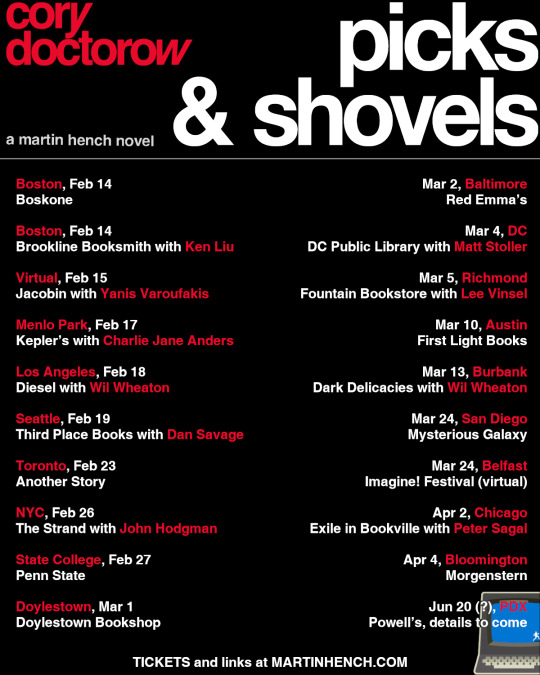
If you'd like an essay-formatted version of this post to read or share, here's a link to it on pluralistic.net, my surveillance-free, ad-free, tracker-free blog:
https://pluralistic.net/2025/02/18/pikettys-productivity/#reaganomics-revenge

Image: Cryteria (modified) https://commons.wikimedia.org/wiki/File:HAL9000.svg
CC BY 3.0 https://creativecommons.org/licenses/by/3.0/deed.en
--
EFF https://www.eff.org/files/issues/eu-flag-11_1.png
CC BY 4.0 https://creativecommons.org/licenses/by/4.0/deed.en
#pluralistic#thomas piketty#eu#usa#trumpism#national capitalism#piketty#economics#wwi#monopoly#financialization#de-dollarization
306 notes
·
View notes
Text
In the energy sector, maintenance costs and downtime can significantly affect output and profitability.. a tool developed by Microsoft is increasingly being used to address these challenges by automating routine tasks and optimizing workflows, resulting in reduced operational disruptions and lower maintenance costs. One of the primary ways Power Automate benefits the energy industry is by minimizing downtime. Energy companies rely on a range of complex systems and equipment that require constant monitoring. With Power Automate, companies can create automated workflows that monitor these systems in real time, sending alerts when anomalies are detected, or issues are imminent. This proactive approach allows companies to address problems before they lead to system failures, preventing costly downtime and service interruptions. Additionally, Power Automate enhances maintenance efficiency by automating the scheduling and execution of routine tasks. Regular maintenance is crucial for ensuring that equipment operates at peak performance, but traditional manual scheduling and task management can be inefficient and error-prone. With Power Automate, maintenance tasks are automatically scheduled based on predefined parameters such as equipment usage, age, or manufacturer recommendations. This ensures that preventative maintenance is completed on time, reducing the likelihood of unexpected breakdowns and extending the lifespan of equipment. Another significant benefit of Power Automate is its ability to streamline data management and improve decision-making. The platform can gather and process vast amounts of data from different systems, providing energy companies with actionable insights. These insights enable better forecasting and maintenance planning, allowing businesses to allocate resources more effectively and avoid unnecessary costs. By reducing unplanned downtime and optimizing maintenance schedules, Power Automate helps energy companies decrease maintenance costs and improve operational efficiency. It also frees up valuable time for employees, allowing them to focus on higher-level tasks rather than manual, time-consuming processes. In conclusion, Power Automate is a game-changer for the energy sector, providing an effective solution to minimize downtime, lower maintenance costs, and improve overall operational efficiency. As the energy industry continues to evolve, adopting automation tools like Power Automate will be crucial for staying competitive and maximizing profitability.
#hire microsoft power automate consultants#microsoft flow consulting services#microsoft power automate consultants#microsoft power automate consulting#microsoft power automate services#power automate consulting provider#power automate consulting services#power automate development#power automate development services#power automate services#power automate solutions provider#power automate workflows#power platform development#workflow automation solutions
1 note
·
View note
Text
I got gifted Vietnam War, it feels like having a dream about Arma. Wild game. Has a dedicated "Kill Civs" command button if you're playing on the US side. You spawn into a firebase, Your Squadmate Microsoft Sam says "I wish I had a Hamburger." You light a cigarette. Your Smoking Skill increases. VC sporadically attack the camp. You get a steady flow of orders which seem impossible, but there's no penalty for not completing them. You kill a few VC and one of them has 4$. You wish your tour was over so you could go to Hawaii (Full maps of various US states as a postgame(?)) And It looks like this:



120 notes
·
View notes
Text

Writer Spotlight: Jamie Beck
Jamie Beck is a photographer residing in Provence, France. Her Tumblr blog, From Me To You, became immensely successful shortly after launching in 2009. Soon after, Jamie, along with her partner Kevin Burg, pioneered the use of Cinemagraphs in creative storytelling for brands. Since then, she has produced marketing and advertising campaigns for companies like Google, Samsung, Netflix, Disney, Microsoft, Nike, Volvo, and MTV, and was included in Adweek Magazine’s “Creative 100” among the industry’s top Visual Artists. In 2022, she released her first book, An American in Provence, which became a NYT Bestseller and Amazon #1 book in multiple categories, and featured in publications such as Vogue, goop, Who What Wear, and Forbes. Flowers of Provence is Jamie’s second book.
Can you tell us about how The Flowers of Provence came to be?
I refer to Provence often as ‘The Garden of Eden’ for her harmonious seasons that bring an ever-changing floral bounty through the landscape. My greatest joy in life is telling her story of flowers through photography so that we may all enjoy them, their beauty, their symbolism, and their contribution to the harmony of this land just a bit longer.

(Photograph: Jamie Beck)
How do your photography and writing work together? Do you write as part of your practice?
I constantly write small notations, which usually occur when I am alone in nature with the intention of creating a photograph or in my studio working alone on a still life. I write as I think in my head, so I have made it a very strict practice that when a thought or idea comes up, I stop and quickly write the text in the notes app on my phone or in a pocket journal I keep with me most of the time. If I don’t stop and write it down at that moment, I find it is gone forever. It is also the same practice for shooting flowers, especially in a place as seasonal as Provence. If I see something, I must capture it right away because it could be gone tomorrow.

(Photograph: Jamie Beck)
You got your start in commercial photography. What’s something you learned in those fields that has served you well in your current creative direction?
I think my understanding of bridging art and commerce came from my commercial photography background. I can make beautiful photographs of flowers all day long, but how to make a living off your art is a completely different skill that I am fortunate enough to have learned by working with so many different creative brands and products in the past.

(Photograph: Jamie Beck)
Do you remember your first photograph?
Absolutely! I was 13 years old. My mother gave me her old Pentax 35mm film camera to play with. When I looked through the viewfinder, it was as if the imaginary world in my head could finally come to life! I gave my best friend a makeover, put her in an evening gown in the backyard of my parents’ house in Texas, and made my first photograph, which I thought was so glamorous! So Vogue!
You situate your photographic work with an introduction that charts the seasons in Provence through flowers. Are there any authors from the fields of nature writing and writing place that inspire you?
I absolutely adore Monty Don! His writing, his shoes, and his ease with nature and flowers—that’s a world in which I want to live. I also love Floret Flowers, especially on social media, as a way to learn the science behind flowers and how to grow them.
How did you decide on the order of the images within The Flowers of Provence?
Something I didn’t anticipate with a book deal is that I would actually be the one doing the layouts! I assumed I would hand over a folder of images, and an art director would decide the order. At first, it was overwhelming to sort through it all because the work is so personal, and I’m so visual. But in the end, it had to be me. It had to be my story and flow to be truly authentic. I tried to move through the seasons and colors of the landscape in a harmonious way that felt a bit magical, just as discovering Provence has felt to me.

(Photograph: Jamie Beck)
How do you practice self-care when juggling work and life commitments alongside the creative process?
The creative process is typically a result that comes out of taking time for self-care. I get some of my best ideas for photographic projects or writing when I am in a bath or shower or go for a long (and restorative) walk in nature. Doing things for myself, such as how I dress or do my hair and makeup, is another form of creative expression that is satisfying.
What’s a place or motif you’d like to photograph that you haven’t had a chance to yet?
I am really interested in discovering more formal gardens in France. I like the idea of garden portraiture, trying to really capture the essence and spirit of places where man and nature intertwine.
Which artists do you return to for inspiration?
I’m absolutely obsessed with Édouard Manet—his color pallet and subject matter.
What are three things you can’t live without as an artist?
My camera, the French light, and flowers, of course.
What’s your favorite flower to photograph, and why?
I love roses. They remind me of my grandmother, who always grew roses and was my first teacher of nature. The perfume of roses and the vast variety of colors, names, and styles all make me totally crazy. I just love them. They simply bring me joy the same way seeing a rainbow in the sky does.

(Photograph: Jamie Beck)
#writer spotlight#jamie beck#the flowers of provence#art#photography#flowers#cottagecore#aesthetics#naturecore#flowercore#still life#nature aesthetic#artist#artists on tumblr#fine art photography#long post#travel#France#Provence#original photographers#photographers on tumblr
1K notes
·
View notes
Text
#power apps microsoft 365#power apps use cases#powerapps flow#Powerapps licensing#canvas power apps#powerplatform microsoft
0 notes
Text

How Obama Transformed the U.S. Intelligence System into an Untouchable Force
The sprawling U.S. intelligence apparatus wasn’t Barack Obama’s invention, it emerged in the wake of 9/11 under George W. Bush, who laid the groundwork with the Patriot Act and a retooled security state. But Obama didn’t just inherit this system; he refined it, expanded it, and entrenched it so deeply into the fabric of American governance that it became nearly impossible for anyone, even a president, to rein it in. His tenure marked a pivotal shift, normalizing a decentralized, privatized, and largely unaccountable intelligence leviathan. Here’s how it unfolded.
The story begins in the early 2000s, when the Bush administration responded to the September 11 attacks with sweeping surveillance powers and a new security architecture. The Patriot Act of 2001 granted agencies like the NSA and FBI unprecedented authority to monitor communications, often sidestepping traditional oversight. By the time Obama took office in 2009, this framework was already in place, but it was still raw, controversial, and subject to scrutiny. Obama’s task wasn’t to build it from scratch; it was to polish it, protect it, and make it permanent.
One of his earliest moves came in 2011, when he signed a renewal of the Patriot Act with a Democratic-controlled Congress. Rather than scaling back Bush-era policies, he leaned into them, signaling that the post-9/11 security state wasn’t a temporary overreach but a new baseline. That same year, he authorized the drone strike that killed Anwar al-Awlaki, a U.S. citizen, without judicial review—a decision rooted in a secretive “Disposition Matrix,” a kill-list system driven by CIA intelligence and insulated from external oversight. Over his presidency, Obama would greenlight over 500 drone strikes, far surpassing Bush’s tally, establishing a precedent for extrajudicial action that relied heavily on intelligence feeds.
Surveillance took a leap forward under Executive Order 12333, which Obama expanded to allow warrantless collection and sharing of raw signals intelligence (SIGINT) across federal agencies. What had once been concentrated in the NSA and FBI now seeped into every corner of the government, from the Department of Homeland Security to the Treasury. This decentralization diluted accountability, as data flowed freely between departments with little public scrutiny.
The 2013 Snowden leaks threw a spotlight on this system. Edward Snowden, a contractor for Booz Allen Hamilton working with the NSA, exposed illegal mass surveillance programs like PRISM and bulk metadata collection, revealing how deeply the government had tapped into private tech giants, Google, Facebook, Microsoft, Apple. Obama’s response was telling: he defended the programs, prosecuted whistleblowers like Snowden, and declined to hold the architects accountable. PRISM became a blueprint for a public-private surveillance partnership, unregulated by Congress, immune to FOIA requests, and beyond democratic reach. Meanwhile, the reliance on contractors like Booz Allen ballooned, by the end of his tenure, 70–80% of the intelligence budget flowed through private firms, funneling billions into an opaque ecosystem.
Obama also shielded the intelligence community from legal consequences. In 2014, the Senate’s Torture Report laid bare CIA abuses, black sites, waterboarding, and even spying on the Senate investigators themselves. Yet Obama refused to prosecute, famously urging the nation to “look forward, not backward.” This stance didn’t just protect individuals; it cemented a culture of impunity, signaling that the intelligence apparatus operated above the law.
Beyond surveillance and legal protections, Obama supercharged the bureaucracy. The Office of the Director of National Intelligence (ODNI), created under Bush, gained sweeping coordination powers under his watch, but rather than centralizing control, it added layers of insulation between the president and field operations. He also empowered hybrid units like Joint Special Operations Command (JSOC) and CIA task forces, which blended military and intelligence functions. These shadowy outfits operated in dozens of countries with lethal authority, secretive chains of command, and minimal oversight from Congress or even their own headquarters.
By 2017, as his presidency wound down, Obama made a final play: he authorized a rule change allowing the NSA to share raw, unfiltered data with 16 other intelligence agencies, stripping away privacy safeguards. This move ensured that the system he’d built could hum along without presidential intervention, its reach embedded in local “fusion centers,” secret courts, and corporate data pipelines.
The outcome was staggering. By the time Obama left office, the intelligence network spanned 17 agencies, leaned heavily on unaccountable contractors, and fused with private tech infrastructure. It wasn’t just bigger, it was untouchable, legalized through executive loopholes and shielded from reform. Obama became the first president to weave intelligence into every layer of government, from foreign policy to law enforcement, but in doing so, he relinquished control. The republic did too. No future leader would easily dismantle this machine, not because it was too strong, but because it had become too diffuse, too ingrained, too essential to the modern state. Obama's Intelligence Policy
#obama#democrats#nsa#surveillance#Snowden#cia#republicans#donald trump#jd vance#robert kennedy jr#tulsi gabbard#maga#joe biden
51 notes
·
View notes
Text
what i did and didn't (but mostly didn't) like about until dawn remake's character trait changes
hello friends and fans. i am super excited to welcome all my pals back to the latest episode of Laura Yaps About Until Dawn Remake. i've talked about the prologue here and here, and i plan on talking about other elements of the game (visuals, gameplay, narrative changes) whenever life and time allows.
before i go off about the character traits, thanks to @claarria for posting this handy side-by-side of old vs new. super helpful! i'll be using those images here.
and generally speaking, let it be known that i think the font change is so fucking ugly 💖 like god bless but it is so bad 💖💖 and they've made the layout so much less dynamic by just listing all the traits straight down, bullet point style?? it is all very microsoft powerpoint core and it sucks. anyway. onto the characters, in order of appearance.
sam

off topic but very importantly, how did they fuck up sam's face THAT bad?? ballistic moon sapped the life out of her and now there is literally nothing behind those eyes. HOMEGIRL WAKE UP 👏👏
one trait change here: adventurous -> brave. not wrong, but super redundant, because brave is one of the character stats in the menu, so like. at any point when i'm playing her, i can pop in the menu and see exactly how brave she is. it's pointless to put it here.
chris

one change: methodical -> loyal. and honestly. this one slays i can't lie. like yeahhhh 🔥🔥🔥🔥🔥
i know everyone loves to hate on chris now, but he pushes to help sam even when it puts himself at risk and he goes to the shed to get josh even though josh just traumatized the hell out of him lmao. boy is loyal asf and i'm more than happy to see it replace methodical.
jess

big changes here. i'm not jazzed to see confident go. i always thought smg included it purposefully, because this is how jess is trying to come across, even though she's actually insecure.
and imo trusting fits her far better than, say, driven. based on em's comment about her grades (and the fact that jess doesn't deny it lmao), i don't think she has much drive or ambition at this point in her life. she's always struck me as the kind of person who doesn't have a big dream or passion, and as high school graduation approaches she would feel sort of aimless? like she doesn't know where to go next.
i don't mean these as negatives, btw. jess is a top 3 ud character for me. i just don't think she's driven. and i think she is irreverent. and that's fine. 💖
emily

one change: persuasive -> forthright. like sam's change, this isn't wrong. emily is definitely forthright. but i don't like that we're shifting her further from mike (more on that later), and this change makes her use of words seem less purposeful. like she says what she wants just for the sake of it, instead of: she knows what to say to get people to do what she wants.
matt

matt's trait changes make for a much different impression. motivated and ambitious have been swapped with obliging and dependable, which shifts the focus from himself to others. we're drawing attention to an agreeable, go-with-the-flow personality, rather than the fact that he's got big dreams for himself (get that scholarship, bud).
i'm not sure i'm the biggest fan, because it kind of makes him seem like a doormat? it's possible that he never talks to emily about how she treats him, and he does film the prank on hannah even though he doesn't seem like he would. still...i guess i wish there was more of a mix here. he can be obliging and dependable, but he doesn't have to be, depending on your choices, and this really makes him feel like everything he does is for the sake of others.
mike

i appreciate ballistic moon pulling these shots back a little - some of them were really, like, up the character's nose lmfao. but bro those traits are unreadable against mike's skin 😭😭
anyway, mikey gets a complete overhaul. i've been over brave with sam. it's a waste of a slot. and it's not that mike isn't driven or charismatic. i mean, he is definitely charismatic, given his popularity in fandom. even i have this feeling of 'man, i should not be charmed by him' <- is definitely charmed by him. but i think we're losing a lot by separating him from emily, with whom he used to share 2 out of 3 traits (intelligent and persuasive). i always thought that said a lot about why they would be drawn to each other and start a relationship - but also why that relationship wouldn't last.
if i were to give mike any new trait, it'd probably be impulsive, which i think is a great fit for him. mike may be intelligent, but when it comes to decisions, he's a man of action - a doer, not a thinker. which is just as likely to lead to a bad outcome as it is a good one.
ashley

one change here (forthright -> sensitive), but god does it fucking suck. SENSITIVE?????? be fr. is ashley sensitive or is she traumatized nonstop for eight hours? she was upset when she was chained to a wall and thought she was going to die! when she thought her friend died! when she thought her other dead friend's ghost was trying to communicate with them! when she was put in a life-or-death trap a second time! that sure was sensitive of her!
if i could revert only one trait change, it would be this one. 0/10.
josh

must be said that josh's shot is much better in the remake. it could not have been worse, like i will never understand how anyone looked at that half-closed eye and open mouth and was like yeah that's a good first impression LMAO. so, cool with that.
tbh i also like josh's trait changes? this is another total overhaul, but honestly, at the risk of getting booed offstage, i'm happy with this. if i'm being real, complex was always a waste of a slot. like...yeah? i hope so? all of your characters should be complex to some degree. it feels like a weird shade to the other characters to point out one guy, specifically, as complex. so the rest of them are simple, then? 🤨 it's not that i would argue against josh being the most complex - i do think he is (though i realize my stance on that means little because i'm up this man's ass). it's just weird to draw attention to it.
as for the other traits, yeah, josh is thoughtful and loving. for sure. but i feel like these are sort of...level 2 traits. ykwim? and the new traits are level 1. if you hung out with josh in a casual way, in a group setting, remake traits would be more likely to spring to mind, to match that initial impression. i think you'd have to look more closely or spend more time to clock that he's thoughtful and loving, because outside of his sisters, i don't think he's particularly straightforward or overt in the way he conveys those things, and he wouldn't draw attention to them. maybe i'm leaning too hard on the version of him i've fleshed out in my mind, but josh is the kind of guy who would, like, remember one offhand comment matt made about liking a specific brand of beer. months later, at the next lodge trip, it's there in the fridge, and josh says nothing about it. but he remembered, and he got it. that's josh's brand of thoughtfulness. in my opinion.
none of these six traits are wrong, i just think the new ones are better 'first impression' traits for him.
#wow look at that i wrote the most about josh. who could've guessed#anyway many tags ahoy because the gang's all here!!!#until dawn#until dawn remake spoilers#sam giddings#chris hartley#jess riley#emily davis#matt taylor#mike munroe#ashley brown#josh washington
94 notes
·
View notes